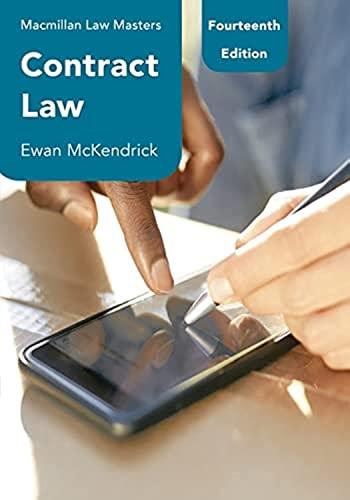Question
40 S.Ct. 382 Supreme Court of the United States. STATE OF MISSOURI v. HOLLAND, U. S. Game Warden. No. 609. | Argued March 2, 1920.
40 S.Ct. 382 Supreme Court of the United States.
STATE OF MISSOURI v. HOLLAND, U. S. Game Warden.
No. 609. | Argued March 2, 1920. | Decided April 19, 1920.
In 1916, Great Britain and the United States agreed that certain species of birds were tremendously valuable to the environment but were at risk of becoming extinct. If you are curious why Great Britain and the United States had a vested interest in the same birds given that they are separated by a huge ocean, remember that Canada was part of Great Britain until 1931. Great Britain (advocating for its Canadian colony) and the United States entered into a treaty, a formal contract between two or more nations. The Migratory Bird Treaty of 1916 required Great Britain (and, by extension, Canada) and the United States to create laws that would protect certain migratory birds.
Consistent with its obligations under the treaty, the US Congress passed a series of statutes called the Migratory Bird Treaty Act of 1918. We will refer to the congressional statutes as the MBTA. According the MBTA, it was illegal to kill, capture, or sell any birds (or their feathers, eggs, and nests) listed in the treaty. There are a couple of very limited exceptions, but the main force of the statutes is to protect migratory birds from harm caused by people. The MBTA also authorized the creation of a list (that matched the list agreed upon in the treaty) of birds protected by the statutes.
After the law was passed, the state of Missouri filed a lawsuit against the United States alleging that the MBTA was an unconstitutional exercise of federal power. Missouri argued that Missouri - and only Missouri - had the authority to regulate wildlife found within its borders.
The case ofMissouri v Holland was heard before the United States Supreme Court on March 2, 1920. Review the attachment and answer the following questions:
6. In the decision, the Court references the prior cases of US v Shauver and US v McCullaugh. These cases dealt with earlier federal laws that regulated migratory birds. Did the courts uphold the constitutionality of these earlier federal laws?
7. Considering your answer to #5, why does the Court treat the Missouri v Holland case differently?
8. What does the Court in Missouri v Hollandultimately decide regarding the constitutionality of the MBTA? Why?
9. According to this decision, is the power to regulate migratory birds an example of a(n) express, implied, or reserved power?
Step by Step Solution
There are 3 Steps involved in it
Step: 1

Get Instant Access to Expert-Tailored Solutions
See step-by-step solutions with expert insights and AI powered tools for academic success
Step: 2

Step: 3

Ace Your Homework with AI
Get the answers you need in no time with our AI-driven, step-by-step assistance
Get Started


